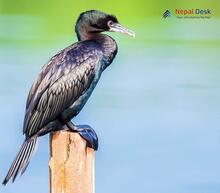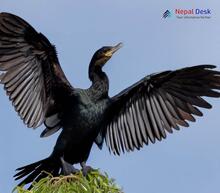The biodiversity of our planet is vast and fascinating, with numerous species adapting and evolving to fill unique ecological niches. Among the varied avian world, the Microcarbo genus stands out as an intriguing group of birds. Often referred to as pygmy cormorants, these small waterbirds possess a rich history in evolution, taxonomy, and morphology. In this article, we will delve into the realm of Microcarbo, its ecology, the species list, and its existence in Nepal.
Evolution and Taxonomy
Belonging to the family Phalacrocoracidae, members of the Microcarbo genus exemplify a classic example of divergent evolution. These species have adapted to specific environments by evolving distinctive morphological features that set them apart from other cormorants. Presently, four recognized species exist under this genus: Microcarbo pygmaeus (Pygmy Cormorant), Microcarbo niger (Little Cormorant), Microcarbo melanoleucos (Australian Little pied Cormorant), and Microcarbo coronatus (Crowned Cormorant).
Morphology
Members of the Microcarbo genus are relatively smaller than other cormorants. They exhibit an array of interesting morphological characteristics that enable them to survive in various ecological niches. Some common attributes include webbed feet for efficient swimming and diving capabilities, slender bodies for efficient underwater foraging movements, sharp bills designed to capture prey efficiently, and dense plumage providing necessary insulation against aquatic environments.
Ecology
Like their larger counterparts in the Phalacrocoracidae family, Microcarbo species primarily inhabit wetlands such as lakes, marshes, and riversides alongside coastal areas. Their diet consists mainly of fish but also includes other small aquatic animals like crustaceans and amphibians. The Microcarbo genus plays a crucial role in controlling their prey populations, ultimately maintaining balance within their ecosystem.
Species List
As mentioned earlier, four species belong to the Microcarbo genus, each occupying unique ecological niches:
1. Microcarbo pygmaeus (Pygmy Cormorant) - Found in Eastern Europe, Western Asia, and Central Asia.
2. Microcarbo niger (Little Cormorant) - Widespread across India, Southeast Asia, Indonesia, and New Guinea Island regions.
3. Microcarbo melanoleucos (Australian Little pied Cormorant) - Occupies Australia, New Zealand, and surrounding islands.
4. Microcarbo coronatus (Crowned Cormorant) - Restricted to the coastal regions of South Africa and Namibia.
Existence in Nepal
The presence of Microcarbo species in Nepal has been documented through ornithological studies and birdwatching records. The Little Cormorant (Microcarbo niger) is a regular resident in Nepal's aquatic habitats such as wetlands and rivers. As one of the national biodiversity hotspots and an important migration corridor, Nepal continues to provide suitable habitats for this unique group of birds.
In conclusion, the Microcarbo genus showcases nature's remarkable adaptive processes through its diverse habitat selection by various species. Understanding and appreciating these birds' evolution, taxonomy, morphology, ecology, and geographic distribution contribute significantly to our overall comprehension of avian biodiversity. Furthermore, conserving these aquatic habitats becomes vital for their survival and maintaining the intricate balance within ecosystems worldwide – including Nepal's rich natural heritage.




